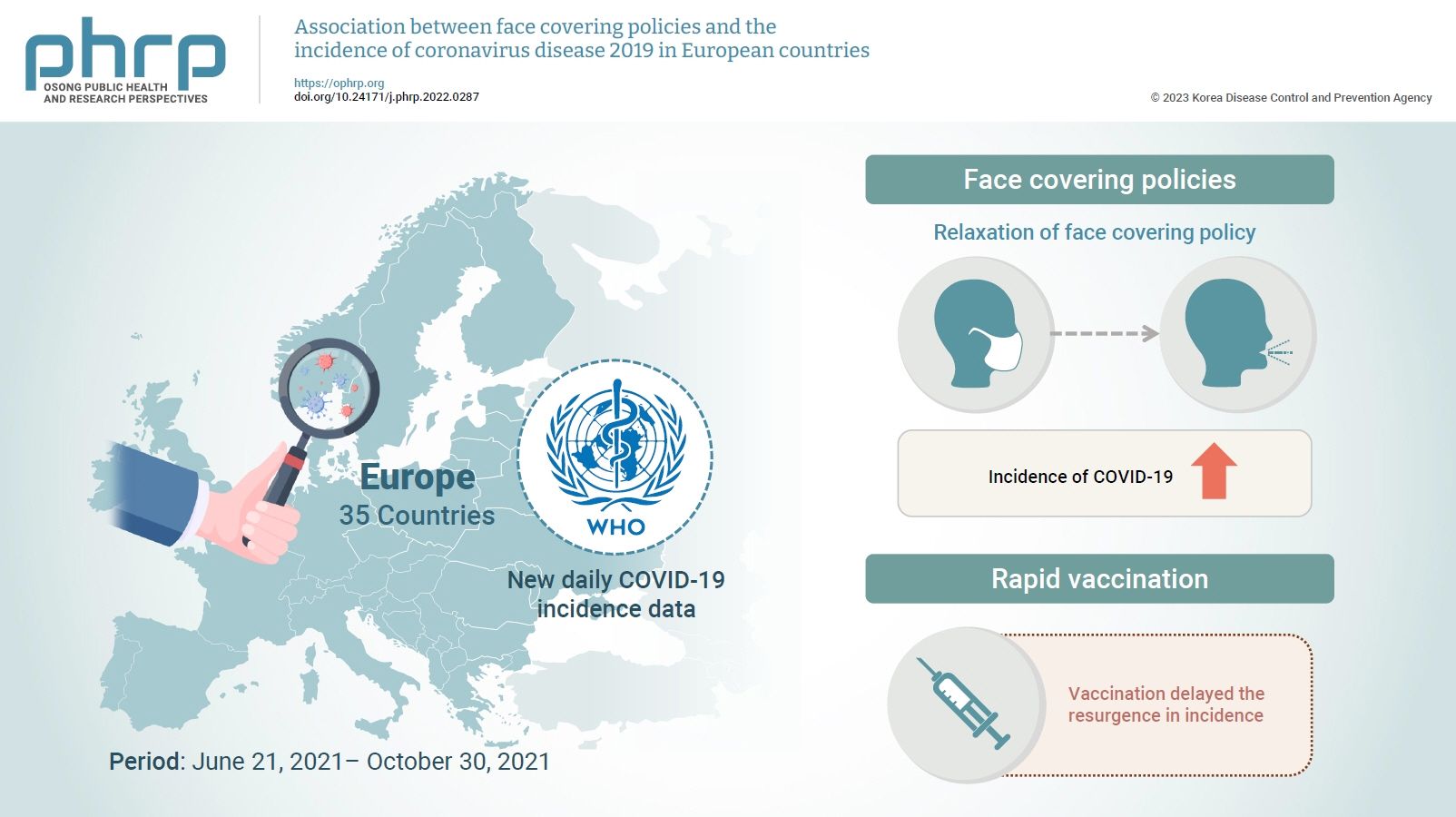- Association between face covering policies and the incidence of coronavirus disease 2019 in European countries
-
Sookhyun Kim, Jiyoung Oh, Sangwoo Tak
-
Osong Public Health Res Perspect. 2023;14(1):31-39. Published online February 1, 2023
-
DOI: https://doi.org/10.24171/j.phrp.2022.0287
-
-
 Graphical Abstract Graphical Abstract
 Abstract Abstract
 PDF PDF
 - Objectives
This study was conducted to determine the impact of the strengthening or relaxation of face covering mandates on the subsequent national case incidence of coronavirus disease 2019 (COVID-19) in Europe as the full vaccination rate was increasing.
Methods
European countries in which case incidence increased for 3 consecutive weeks were monitored and analyzed using COVID-19 incidence data shared by the World Health Organization (WHO). The epidemic trend of COVID-19 in Europe was compared with that of countries elsewhere in the world based on WHO weekly epidemiological reports from June 20 to October 30, 2021. In addition, this study provided insight into the impact of government mask mandates on COVID-19 incidence in Europe by measuring the index scores of those facial covering policies before and after mandate relaxation or strengthening. The effects of the vaccination rate and the speed of vaccination on COVID-19 incidence were also analyzed.
Results
The incidence of COVID-19 after the relaxation of face covering mandates was significantly higher than before relaxation. However, no significant difference was observed in vaccination rate between countries with increased and decreased incidence. Instead, rapid vaccination delayed the resurgence in incidence.
Conclusion
The findings suggest that face covering policies in conjunction with rapid vaccination efforts are essential to help mitigate the spread of COVID-19.
- COVID-19 outbreak and risk factors for infection in a taekwondo gym in the Republic of Korea
-
Seung Hwan Shin, Eonjoo Park, Sookhyun Kim, Minji Jang, Subin Park, Dong-Hwi Kim, Tae Jong Son, Ji-Hyuk Park
-
Osong Public Health Res Perspect. 2022;13(2):162-170. Published online March 31, 2022
-
DOI: https://doi.org/10.24171/j.phrp.2021.0295
-
-
4,324
View
-
115
Download
-
6
Web of Science
-
5
Crossref
-
 Abstract Abstract
 PDF PDF
- Objectives
Relatively few studies have assessed risk factors for coronavirus disease 2019 (COVID-19) in public facilities used by children and adolescents. This study presents an analysis of a COVID-19 outbreak that occurred in a taekwondo gym in Korea, predominantly among children and adolescents, with the aim of providing insights on managing COVID-19 outbreaks in similar facilities. Methods: All 108 taekwondo gym students and staff received COVID-19 tests. A survey and closed-circuit television analyses were used to identify risk factors. A univariate analysis was conducted, followed by multivariate logistic regression analysis with backward elimination for variables with a significance level <0.10 in the univariate analysis. Results: COVID-19 was confirmed in 30 of 108 subjects at the taekwondo gym (attack rate, 27.8%). The outbreak started in an adult class student. This student transmitted the virus to the staff, who consequently transmitted the virus to adolescent students. In the univariate analysis, the relative risk for younger age (≤9 years) was 2.14 (95% confidence interval [CI], 1.01–4.54; p=0.054), and that for food consumption inside the gym was 2.12 (95% CI, 1.04–4.30; p=0.048). In the multivariate logistic regression analysis, the odds ratio for younger age was 2.96 (95% CI, 1.07–8.20; p=0.036), and that for food consumption inside the gym was 3.00 (95% CI, 1.10–8.17; p=0.032). Conclusion: Food consumption inside the facility and young age were significant risk factors for COVID-19 transmission in this taekwondo gym. Food consumption should be prohibited in sports facilities, and infection prevention education for young students is also required.
-
Citations
Citations to this article as recorded by  - The First Outbreak of Novel Coronavirus Disease 2019 (COVID-19) at an Outdoor Camping Site in South Korea, 2020
Na-Young Kim, Seonhee Ahn, GwangJin Kim, Donghyok Kwon, Young-Joon Park, Sang-Eun Lee
Journal of Epidemiology.2024; 34(4): 203. CrossRef - Risk evaluation of venue types and human behaviors of COVID-19 outbreaks in public indoor environments: A systematic review and meta-analysis
Weiwei Huang, Caroline X. Gao, Danting Luo, Yong Wang, Xiaohong Zheng, Cong Liu, Ying Wang, Yuguo Li, Hua Qian
Environmental Pollution.2024; 341: 122970. CrossRef - SARS-CoV-2 transmission modes: Why and how contamination occurs around shared meals and drinks?
Aure Saulnier, Jean-Michel Wendling, Benoit Hermant, Didier Lepelletier
Food Microbiology.2023; 114: 104297. CrossRef - Risk factors for COVID-19 outbreaks in livestock slaughtering and processing facilities in Republic of Korea
Seongju Choi, Tae Jong Son, Yeon-Kyung Lee
Osong Public Health and Research Perspectives.2023; 14(3): 207. CrossRef - Protective facemask-induced facial thermal stress and breathing burden during exercise in gyms
Qilong Zhong, Jiyun Song, Dachuan Shi, Chung-Hin Dung
Building and Environment.2023; 244: 110840. CrossRef
|